Seeking Clearness On The Warning Lights Displayed On Your Automobile'S Dashboard? Find Out Exactly How They Relate To Your Car'S Health And Safety
Seeking Clearness On The Warning Lights Displayed On Your Automobile'S Dashboard? Find Out Exactly How They Relate To Your Car'S Health And Safety
Blog Article
Written By-Boye Stark
When you lag the wheel, those beautiful warning lights on your control panel can be a bit difficult. Do you understand what they're trying to inform you about your car's health? Comprehending the relevance of these lights is vital for your safety and the long life of your lorry. So, the following time one of those lights appears, would not you intend to understand its message accurately and take the necessary steps to address it?
Common Warning Lights and Interpretations
Recognize usual warning lights in your vehicle and recognize their significances to make sure safe driving.
One of the most common warning lights consist of the check engine light, which signifies issues with the engine or emissions system. If this light comes on, it's critical to have your vehicle inspected immediately.
The oil pressure advising light shows low oil stress, needing prompt attention to avoid engine damage.
A blinking battery light may recommend a faulty charging system, potentially leaving you stranded otherwise addressed.
The tire stress surveillance system (TPMS) light notifies you to low tire pressure, influencing automobile security and gas performance. Disregarding this could result in unsafe driving conditions.
The abdominal light shows a trouble with the anti-lock braking system, jeopardizing your ability to quit swiftly in emergency situations.
Finally, the coolant temperature level advising light warns of engine overheating, which can result in serious damage otherwise fixed quickly.
Understanding these common warning lights will aid you attend to problems quickly and maintain safe driving conditions.
Importance of Prompt Attention
Understanding the common warning lights in your automobile is just the primary step; the importance of promptly resolving these warnings can't be emphasized enough to ensure your safety and security when driving.
When a warning light illuminates on your control panel, it's your car's way of communicating a potential concern that requires attention. Overlooking these cautions can bring about a lot more serious issues down the road, jeopardizing your safety and security and possibly costing you a lot more in repairs.
Prompt attention to advising lights can stop failures and accidents. For example, a flashing check engine light could suggest a misfire that, if left unattended, can trigger damages to the catalytic converter. Resolving this without delay can save you from a costly repair work.
In https://daltonmgauo.mybuzzblog.com/9523326/the-progression-of-car-outlining-methods-throughout-the-last-ten-years , a brake system warning light could signify low brake fluid or worn brake pads, crucial elements for your security when driving.
DIY Troubleshooting Tips
If you notice a warning light on your dashboard, there are a couple of do it yourself repairing suggestions you can try prior to seeking professional help.
The first step is to consult your cars and truck's handbook to understand what the certain caution light indicates. Occasionally the issue can be as simple as a loosened gas cap setting off the check engine light. Tightening up the gas cap might deal with the problem.
One more typical issue is a reduced battery, which can activate numerous advising lights. Inspecting https://abc3340.com/news/local/you-better-hang-on-tight-parts-on-back-order-impacting-car-repair-times-vehicles-supply-shortage-supply-chain-mechanics-labor- for rust and ensuring they're safe and secure may fix the issue.
If a warning light continues, you can try resetting it by disconnecting the car's battery for a few minutes and afterwards reconnecting it. In addition, examining your lorry's fluid levels, such as oil, coolant, and brake fluid, can aid fix advising lights associated with these systems.
Verdict
In conclusion, understanding your automobile's caution lights is vital for keeping your vehicle running smoothly and securely. By promptly resolving these notifies and understanding what they imply, you can avoid expensive repair work and potential failures.
Remember to consult your vehicle's manual for specific information on each advising light and take action appropriately to make sure a trouble-free driving experience.
Keep notified, stay secure when driving!
